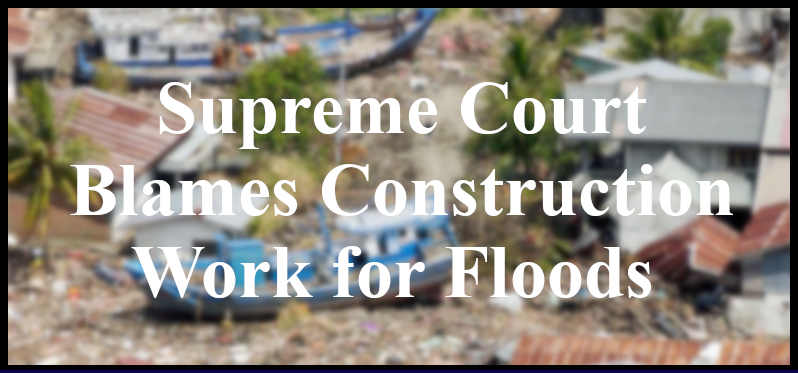
While Delivering Judgement, the Supreme Court had observed that unbridled construction in eco-sensitive regions are the reasons for the unprecedented floods that we have seen in the recent past in various parts of India.
In-Detail
- The Supreme Court while directing the authorities in Kerala to demolish certain apartment blocks that are in violation of the norms of Coastal Regulation Zone (CRZ), observed that construction activities on river shores are the reason for floods in Kerala, Chennai, and Uttarakhand in the recent past.
- In the said case, the local panchayat had given permission to the construction of apartment blocks on a piece of land falls under the CRZ norms.
- The Kerala Coastal Zone Management Authority (KCZMA) filed a Special Leave Petition (SLP) regarding the same with the Supreme Court.
CRZ Rules
- The CRZ rules are framed by the Union Environment Ministry, but the implementation of the rules falls with the state government.
- The rules regulate human and industrial activities across the coastline to protect the fragile ecosystems near the sea.
- Many animals and marine life living near the coast, which needs protection from unregulated human activities.
- These rules are mandated under the Environment Protection Act, 1986.
- Large constructions, setting up of new industries, storage or disposal of hazardous wastes or materials, mining, bunding, reclamation, etc are restricted up to a certain distance from the coastline.
- The regulation zone is 500m from the high tide.
- There are various criteria for applying several restrictions such as the population of the area, distance from the shore, ecological sensitivity, conservation status of the area, etc.
- The rules are evolved over the years with the first set of rules framed in 1991 were hard, then fresh rules were notified in 2011 and further in 2018, the central government had notified new rules.
CRZ Classification
As per the rules, the Coastal Regulation Zones are classified into four zones.
- CRZ-I: this includes areas that are ecologically sensitive such as sanctuaries, coral reefs, mangroves, reserve forests, etc. No construction activity is allowed except for atomic plants and defence installations.
- CRZ-II: These are urban areas where development has reached the shorelines but within the municipal limits.
- CRZ-III: These are mainly rural areas. Here the construction of only dwelling units is allowed that room between 200-500m of the high tide.
- CRZ-IV: the area covered is between the low tide and 12 nautical miles into the sea. Except for fishing and other related activities, activities that affect the sea and tidal waves are regulated.
Two new zones are included with the 2018 rules.
- CRZ-IIIA: These are areas with a population density of 2161 per square kilometre as per 2011 census. These areas will have a no development zone (NDZ) of 50m from the high-tide line.
- CRZ-IIIB: These are rural areas with less than 2161 per square kilometre density and the NDZ is 200m from high-tide line.
Also Read:
- A Landmark Move to Check Plastic Waste Movement Across Countries
- The MANAV Initiative – To Understand the Role of Tissues & Cells
- Chandrayaan-2 Set for a July Launch – ISRO
Conclusion
- The coastal ecosystems, apart from facing the pressures of climate change are also being degraded by human activities.
- The CRZ norms have been framed to deal with this.
- But, violations have been rampant.
- The state Coastal Zone Management Authorities have a clear mandate to protect the notified Coastal Regulation Zone. But still, discrepancies are occurring.

Leave a Reply
You must be logged in to post a comment.